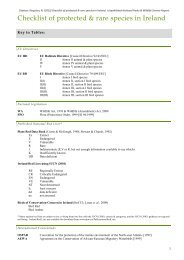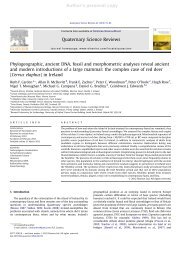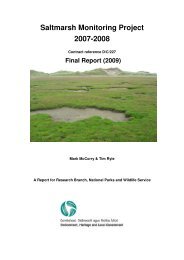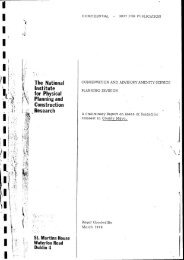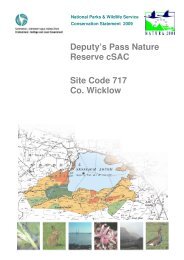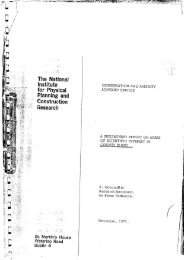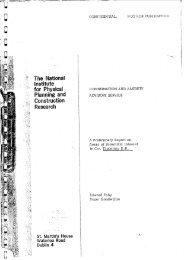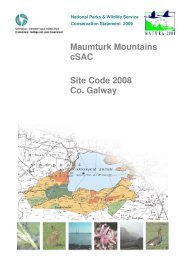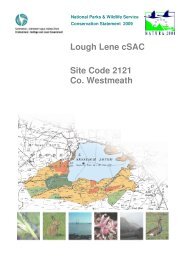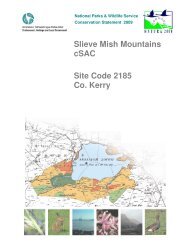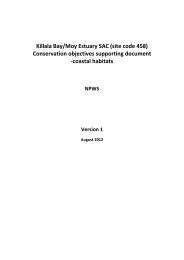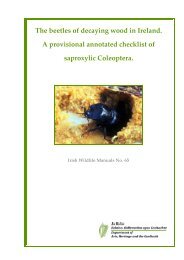The Role of Kelp in the Marine Environment - National Parks ...
The Role of Kelp in the Marine Environment - National Parks ...
The Role of Kelp in the Marine Environment - National Parks ...
You also want an ePaper? Increase the reach of your titles
YUMPU automatically turns print PDFs into web optimized ePapers that Google loves.
� Fr<strong>in</strong>ge Areas<br />
Surface Canopy<br />
A dense and well-developed kelp forest may provide a buoyant mat upon which birds<br />
may perch. This is particularly noted <strong>in</strong> California USA where forests <strong>of</strong> <strong>the</strong> Giant<br />
<strong>Kelp</strong> Macrocystis spp. provide roost sites for various gull species and also a forag<strong>in</strong>g<br />
platform from which <strong>the</strong>y forage for fish and o<strong>the</strong>r prey <strong>in</strong> <strong>the</strong> kelp surface canopy<br />
(Foster & Schiel, 1985).<br />
No Irish records <strong>of</strong> birds rest<strong>in</strong>g with<strong>in</strong> kelp canopies were found dur<strong>in</strong>g <strong>the</strong> current<br />
review but <strong>the</strong>re is <strong>the</strong> potential for some bird species (e.g., gulls Family Laridae) to<br />
rest with<strong>in</strong> this habitat by ei<strong>the</strong>r perch<strong>in</strong>g or swimm<strong>in</strong>g. Indeed many seem<strong>in</strong>gly<br />
unstable <strong>of</strong>fshore structures provide perch<strong>in</strong>g platforms as <strong>the</strong>y are relatively safe<br />
from shore predators and human disturbance. Roycr<strong>of</strong>t et al. (2004) found that<br />
float<strong>in</strong>g mussel long-l<strong>in</strong>e suspension buoys were used as perch<strong>in</strong>g platforms for a<br />
number <strong>of</strong> bird species such as Laridae (gulls), Oystercatcher Haematopus ostralegus,<br />
R<strong>in</strong>ged Plover Charadrius hiaticula, Hooded Crow Corvus corone cornix,<br />
Phalacrocoracidae (Shags and Cormorants), and Black Guillemots Cepphus grylle.<br />
Oystercatchers were also observed forag<strong>in</strong>g along lengths <strong>of</strong> rope <strong>of</strong> mussel long-l<strong>in</strong>e<br />
(D. Roycr<strong>of</strong>t, pers.comm.) which might be considered a particularly small and<br />
unstable forag<strong>in</strong>g habitat.<br />
Mid and Bottom Waters<br />
Little published <strong>in</strong>formation exists as to specific <strong>in</strong>teractions between forag<strong>in</strong>g<br />
seabirds and kelp forests (e.g., Wilk<strong>in</strong>son, 1995).<br />
Families <strong>of</strong> birds that may potentially forage with<strong>in</strong> <strong>in</strong>fralittoral reef kelp forests<br />
<strong>in</strong>clude those commonly us<strong>in</strong>g <strong>in</strong>shore waters:<br />
Gaviidae (Divers) e.g., Great Nor<strong>the</strong>rn Diver Gavia immer.<br />
Podicipedidae (Grebes) e.g., Great Crested Grebe Podiceps cristatus<br />
Phalacrocoracidae e.g., Cormorant Phalacrocorax carbo, Shags<br />
Anatidae (Ducks)<br />
Phalacrocorax aristotelis.<br />
e.g., Eider Somateria mollissima<br />
34



